
Here you can study for the exam. Look up keywords and learn definitions about all kind of subjects.
More subjects
Malpighia emarginata is a tropical fruit-bearing shrub or small tree in the family Malpighiaceae. Common names include acerola cherry, Guarani cherry, Barbados cherry, West Indian cherry, and wild crepe myrtle. Acerola is native to Paraguay and Brazil in South America, Central America and southern Mexico, Puerto Rico, Dominican Republic and Haiti, but is now also being grown as far north as Texas and in subtropical areas of Asia, such as India. (Source: Wikipedia.org, CC BY-SA)
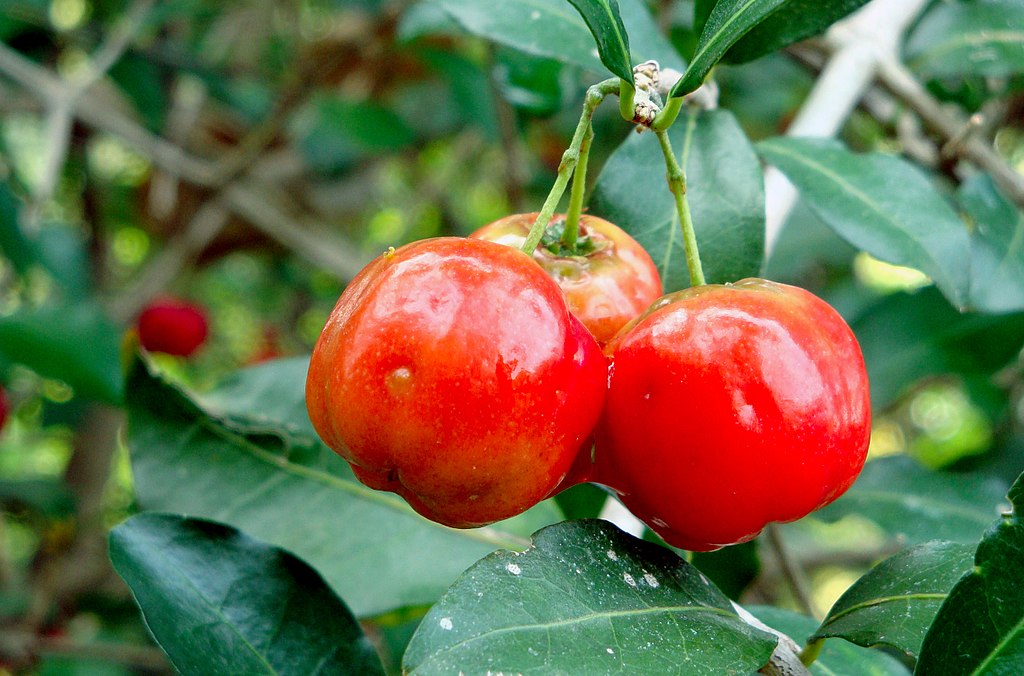 © Wikimedia.org/Marcelo P. B. Silva, CC0
© Wikimedia.org/Marcelo P. B. Silva, CC0
An apple is an edible fruit produced by an apple tree (Malus domestica). Apple trees are cultivated worldwide and are the most widely grown species in the genus Malus. The tree originated in Central Asia, where its wild ancestor, Malus sieversii, is still found today. Apples have been grown for thousands of years in Asia and Europe and were brought to North America by European colonists. Apples have religious and mythological significance in many cultures, including Norse, Greek, and European Christian tradition. Apples grown from seed tend to be very different from those of their parents, and the resultant fruit frequently lacks desired characteristics. Generally, apple cultivars are propagated by clonal grafting onto rootstocks. Apple trees grown without rootstocks tend to be larger and much slower to fruit after planting. Rootstocks are used to control the speed of growth and the size of the resulting tree, allowing for easier harvesting. (Source: Wikipedia.org, CC BY-SA)
 © Wikimedia.org/Scott Bauer, CC0
© Wikimedia.org/Scott Bauer, CC0
An apricot (US: /ˈæprɪkɒt/ , UK: /ˈeɪprɪkɒt/ ) is a fruit, or the tree that bears the fruit, of several species in the genus Prunus. Usually, an apricot is from the species P. armeniaca, but the fruits of the other species in Prunus sect. Armeniaca are also called apricots. The apricot is a small tree, 8–12 m (26–39 ft) tall, with a trunk up to 40 cm (16 in) in diameter and a dense, spreading canopy. The leaves are ovate, 5–9 cm (2.0–3.5 in) long, and 4–8 cm (1.6–3.1 in) wide, with a rounded base, a pointed tip, and a finely serrated margin. The flowers are 2–4.5 cm (0.8–1.8 in) in diameter, with five white to pinkish petals; they are produced singly or in pairs in early spring before the leaves. The fruit is a drupe (stonefruit) similar to a small peach, 1.5–2.5 cm (0.6–1.0 in) diameter (larger in some modern cultivars), from yellow to orange, often tinged red on the side most exposed to the sun; its surface can be smooth (botanically described as: glabrous) or velvety with very short hairs (botanically: pubescent). The flesh is usually succulent, but dry in some species such as P. sibirica. Its taste can range from sweet to tart. The single seed or 'kernel' is enclosed in a hard shell, often called a 'stone', with a grainy, smooth texture except for three ridges running down one side. (Source: Wikipedia.org, CC BY-SA)
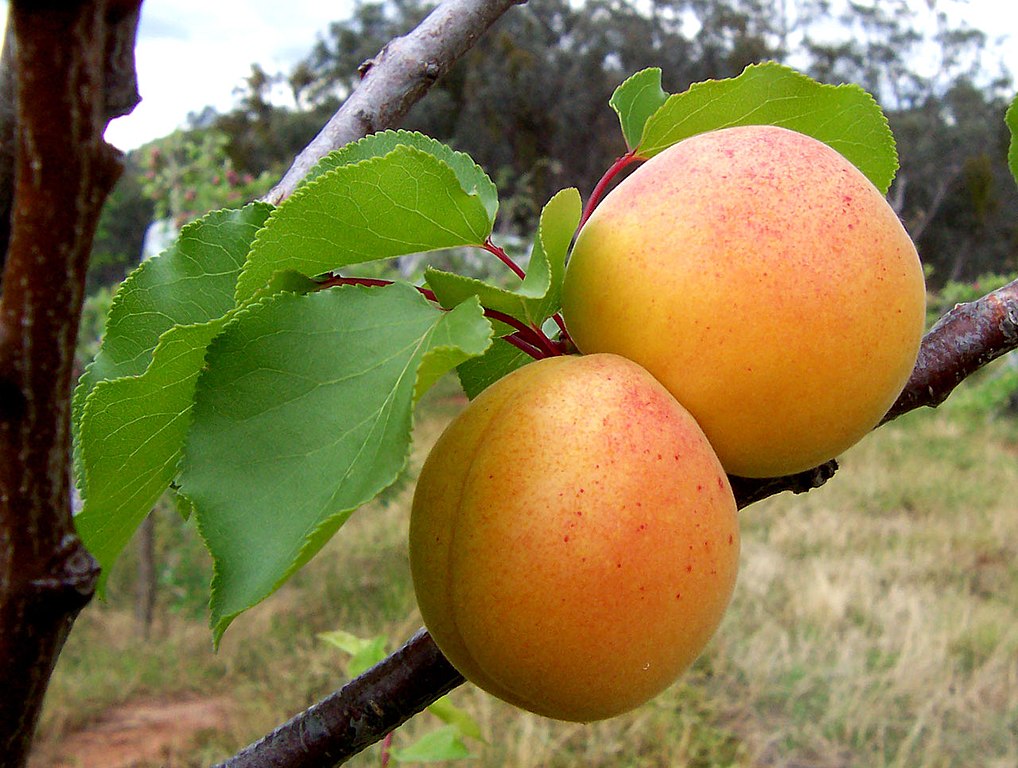 © Wikimedia.org/Fir0002, CC BY-SA
© Wikimedia.org/Fir0002, CC BY-SA
The avocado (Persea americana) is a medium-sized, evergreen tree in the laurel family (Lauraceae). It is native to the Americas and was first domesticated by Mesoamerican tribes more than 5,000 years ago. Then as now it was prized for its large and unusually oily fruit. The tree likely originated in the highlands bridging south-central Mexico and Guatemala. Its fruit, sometimes also referred to as an alligator or avocado pear, is botanically a large berry containing a single large seed. Avocado trees are partially self-pollinating, and are often propagated through grafting to maintain consistent fruit output. Avocados are presently cultivated in the tropical and Mediterranean climates of many countries. Mexico is the world's leading producer of avocados as of 2020, supplying nearly 30% of the global harvest in that year. The fruit of domestic varieties have smooth, buttery, golden-green flesh when ripe. Depending on the cultivar, avocados have green, brown, purplish, or black skin, and may be pear-shaped, egg-shaped, or spherical. For commercial purposes the fruits are picked while immature and ripened after harvesting. The nutrient density and extremely high fat content of avocado flesh are useful to a variety of cuisines and are often eaten to enrich vegetarian diets. (Source: Wikipedia.org, CC BY-SA)
A banana is an elongated, edible fruit – botanically a berry – produced by several kinds of large herbaceous flowering plants in the genus Musa. In some countries, bananas used for cooking may be called 'plantains', distinguishing them from dessert bananas. The fruit is variable in size, color, and firmness, but is usually elongated and curved, with soft flesh rich in starch covered with a rind, which may be green, yellow, red, purple, or brown when ripe. The fruits grow upward in clusters near the top of the plant. Almost all modern edible seedless (parthenocarp) bananas come from two wild species – Musa acuminata and Musa balbisiana. The scientific names of most cultivated bananas are Musa acuminata, Musa balbisiana, and Musa × paradisiaca for the hybrid Musa acuminata × M. balbisiana, depending on their genomic constitution. The old scientific name for this hybrid, Musa sapientum, is no longer used. (Source: Wikipedia.org, CC BY-SA)
The blackberry is an edible fruit produced by many species in the genus Rubus in the family Rosaceae, hybrids among these species within the subgenus Rubus, and hybrids between the subgenera Rubus and Idaeobatus. The taxonomy of blackberries has historically been confused because of hybridization and apomixis, so that species have often been grouped together and called species aggregates. For example, the entire subgenus Rubus has been called the Rubus fruticosus aggregate, although the species R. fruticosus is considered a synonym of R. plicatus. Rubus armeniacus ('Himalayan' blackberry) is considered a noxious weed and invasive species in many regions of the Pacific Northwest of Canada and the United States, where it grows out of control in urban and suburban parks and woodlands. (Source: Wikipedia.org, CC BY-SA)
The blackcurrant (Ribes nigrum), also known as black currant or cassis, is a deciduous shrub in the family Grossulariaceae grown for its edible berries. It is native to temperate parts of central and northern Europe and northern Asia, where it prefers damp fertile soils. It is widely cultivated both commercially and domestically. It is winter hardy, but cold weather at flowering time during the spring may reduce the size of the crop. Bunches of small, glossy black fruit develop along the stems in the summer and can be harvested by hand or by machine. Breeding is common in Scotland, Poland, Lithuania, Latvia, Norway, and New Zealand to produce fruit with better eating qualities and bushes with greater hardiness and disease resistance. The raw fruit is particularly rich in vitamin C and polyphenols. Blackcurrants can be eaten raw but are usually cooked in sweet or savoury dishes. They are used to make jams, preserves, and syrups and are grown commercially for the juice market. The fruit is also used to make alcoholic beverages and dyes. (Source: Wikipedia.org, CC BY-SA)
 © Wikimedia.org/Jerzy Opioła, CC BY-SA
© Wikimedia.org/Jerzy Opioła, CC BY-SA
Blueberries are a widely distributed and widespread group of perennial flowering plants with blue or purple berries. They are classified in the section Cyanococcus within the genus Vaccinium. Vaccinium also includes cranberries, bilberries, huckleberries and Madeira blueberries. Commercial blueberries—both wild (lowbush) and cultivated (highbush)—are all native to North America. The highbush varieties were introduced into Europe during the 1930s. Blueberries are usually prostrate shrubs that can vary in size from 10 centimeters (4 inches) to 4 meters (13 feet) in height. In commercial production of blueberries, the species with small, pea-size berries growing on low-level bushes are known as 'lowbush blueberries' (synonymous with 'wild'), while the species with larger berries growing on taller, cultivated bushes are known as 'highbush blueberries'. Canada is the leading producer of lowbush blueberries, while the United States produces some 40% of the world supply of highbush blueberries. (Source: Wikipedia.org, CC BY-SA)
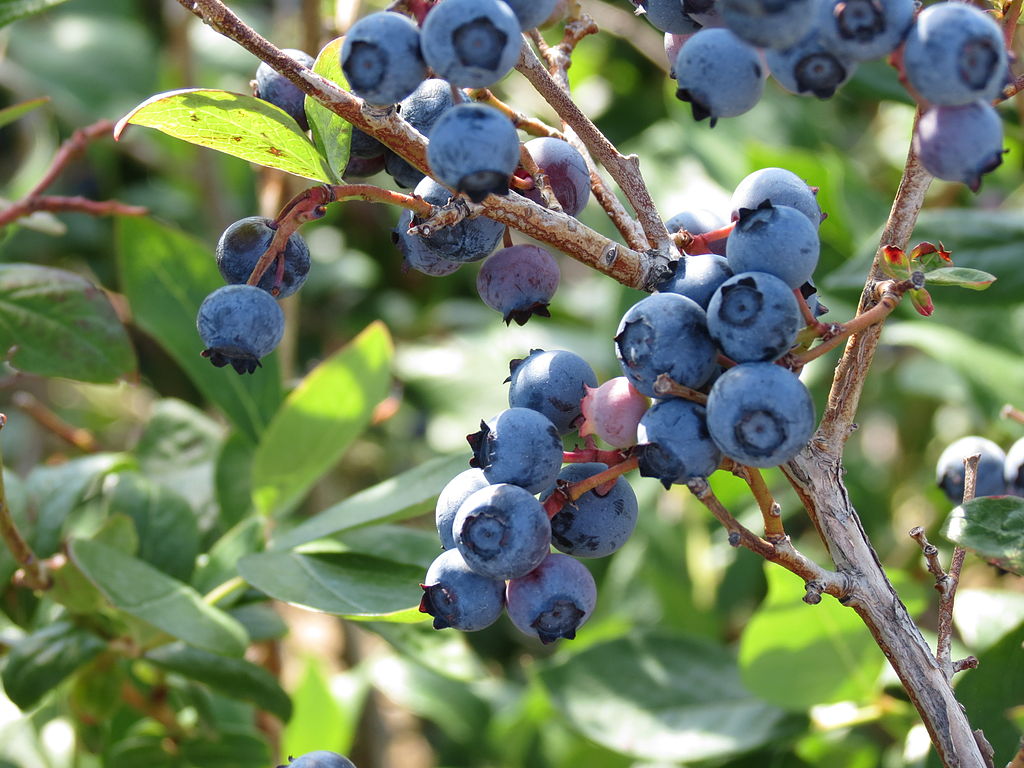 © Wikimedia.org/Corwinhee, CC BY-SA
© Wikimedia.org/Corwinhee, CC BY-SA
Breadfruit (Artocarpus altilis) is a species of flowering tree in the mulberry and jackfruit family (Moraceae) believed to be a domesticated descendant of Artocarpus camansi originating in New Guinea, the Maluku Islands, and the Philippines. It was initially spread to Oceania via the Austronesian expansion. It was further spread to other tropical regions of the world during the Colonial Era. British and French navigators introduced a few Polynesian seedless varieties to Caribbean islands during the late 18th century. Today it is grown in some 90 countries throughout South and Southeast Asia, the Pacific Ocean, the Caribbean, Central America and Africa. Its name is derived from the texture of the moderately ripe fruit when cooked, similar to freshly baked bread and having a potato-like flavor. The trees have been widely planted in tropical regions, including lowland Central America, northern South America, and the Caribbean. In addition to the fruit serving as a staple food in many cultures, the light, sturdy timber of breadfruit has been used for outriggers, ships, and houses in the tropics. (Source: Wikipedia.org, CC BY-SA)
The cantaloupe, rockmelon (Australia and New Zealand, although cantaloupe is used in some states of Australia), sweet melon, or spanspek (Southern Africa) is a melon that is a variety of the muskmelon species (Cucumis melo) from the family Cucurbitaceae. Cantaloupes range in weight from 0.5 to 5 kilograms (1 to 11 lb). Originally, cantaloupe referred only to the non-netted, orange-fleshed melons of Europe, but today may refer to any orange-fleshed melon of the C. melo species. Cantaloupe is normally eaten as a fresh fruit, as a salad, or as a dessert with ice cream or custard. Melon pieces wrapped in prosciutto are a familiar antipasto. The seeds are edible and may be dried for use as a snack. Because the surface of a cantaloupe can contain harmful bacteria—in particular, Salmonella—it is recommended that a melon be washed and scrubbed thoroughly before cutting and consumption. The fruit should be refrigerated after cutting it and consumed in less than three days to prevent risk of Salmonella or other bacterial pathogens. (Source: Wikipedia.org, CC BY-SA)
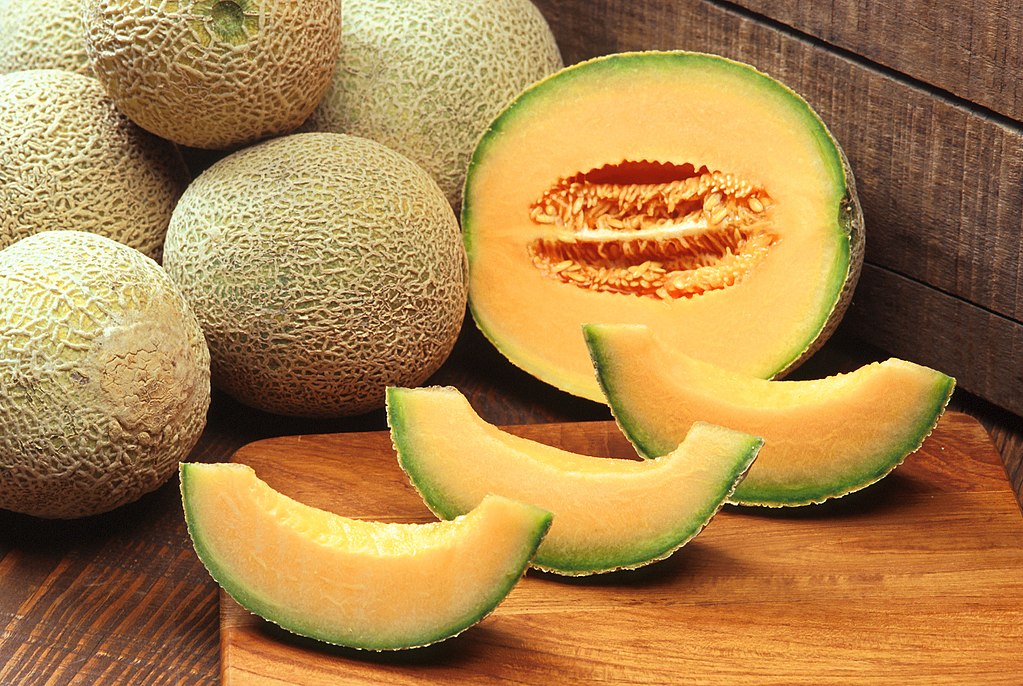 © Wikimedia.org/Scott Bauer, CC0
© Wikimedia.org/Scott Bauer, CC0
Carambola, also known as star fruit, is the fruit of Averrhoa carambola, a species of tree native to tropical Southeast Asia. The mildly poisonous fruit is commonly consumed in parts of Brazil, Southeast Asia, South Asia, the South Pacific, Micronesia, parts of East Asia, the United States, and the Caribbean and contains the neurotoxin caramboxin. The tree is cultivated throughout tropical areas of the world. The fruit has distinctive ridges running down its sides (usually 5–6). When cut in cross-section, it resembles a star, giving it the name of star fruit. The entire fruit is edible, usually raw, and may be cooked or made into relishes, preserves, garnish, and juices. (Source: Wikipedia.org, CC BY-SA)
The cherimoya (Annona cherimola), also spelled chirimoya and called chirimuya by the Inca people, is a species of edible fruit-bearing plant in the genus Annona, from the family Annonaceae, which includes the closely related sweetsop and soursop. The plant has long been believed to be native to Ecuador and Peru, with cultivation practiced in the Andes and Central America, although a recent hypothesis postulates Central America as the origin instead, because many of the plant's wild relatives occur in this area. Cherimoya is grown in tropical and subtropical regions throughout the world including Central America, eastern South America, Southern California, South Asia, Australia, the Mediterranean region and North Africa. American writer Mark Twain called the cherimoya 'the most delicious fruit known to men'. The creamy texture of the flesh gives the fruit its secondary name, the custard apple. (Source: Wikipedia.org, CC BY-SA)
A cherry is the fruit of many plants of the genus Prunus, and is a fleshy drupe (stone fruit). Commercial cherries are obtained from cultivars of several species, such as the sweet Prunus avium and the sour Prunus cerasus. The name 'cherry' also refers to the cherry tree and its wood, and is sometimes applied to almonds and visually similar flowering trees in the genus Prunus, as in 'ornamental cherry' or 'cherry blossom'. Wild cherry may refer to any of the cherry species growing outside cultivation, although Prunus avium is often referred to specifically by the name 'wild cherry' in the British Isles. Like most temperate-latitude trees, cherry trees require a certain number of chilling hours each year to break dormancy and bloom and produce fruit. The number of chilling hours required depends on the variety. Because of this cold-weather requirement, no members of the genus Prunus can grow in tropical climates. (Source: Wikipedia.org, CC BY-SA)
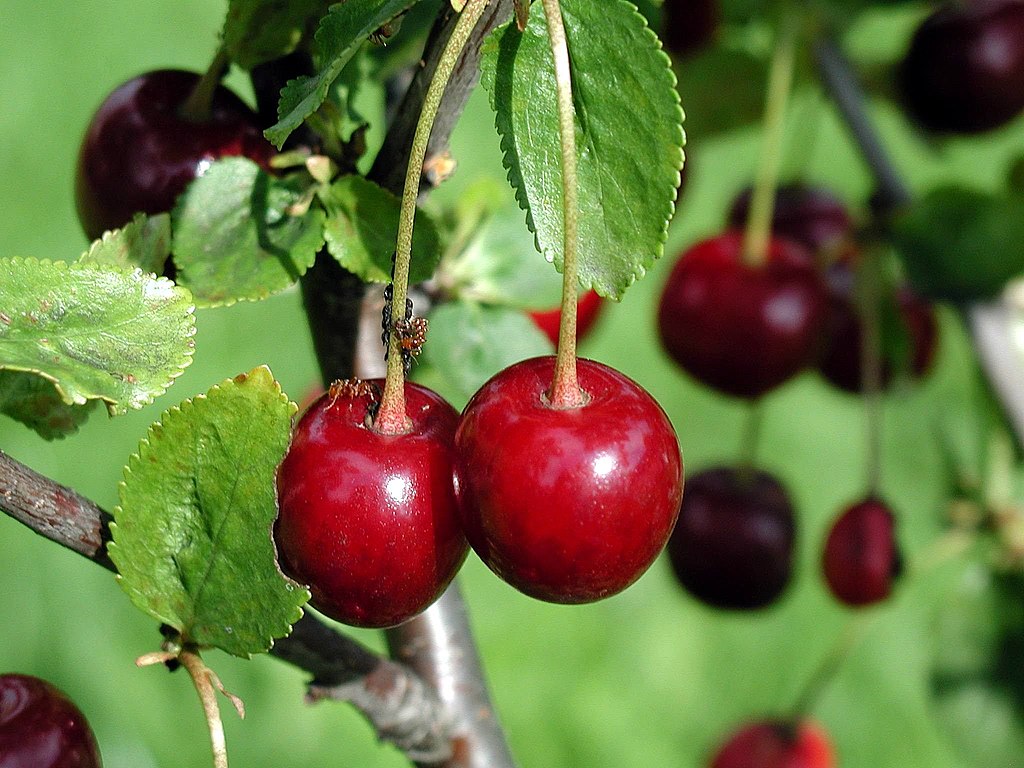 © Wikimedia.org/Paolo Neo, CC0
© Wikimedia.org/Paolo Neo, CC0
A clementine (Citrus × clementina) is a tangor, a citrus fruit hybrid between a willowleaf mandarin orange (C. × deliciosa) and a sweet orange (C. × sinensis), named in honor of Clément Rodier, a French missionary who first discovered and propagated the cultivar in Algeria. The exterior is a deep orange colour with a smooth, glossy appearance. Clementines can be separated into 7 to 14 segments. Similar to tangerines, they tend to be easy to peel. They are typically juicy and sweet, with less acid than oranges. Their oils, like other citrus fruits, contain mostly limonene as well as myrcene, linalool, α-pinene and many complex aromatics. Clementines differ from other citrus in having lower heat requirement, which means the tolerance to fruit maturity and sensitivity to unfavorable conditions during the flowering and fruit-setting period is higher. However, in regions of high total heat, the Clementine bears fruit early; only slightly later than satsuma mandarins. These regions such as North Africa, Mediterranean basin, and California, also favor maximizing the Clementine size and quality. As a result, the tastiest Clementines are from these hot regions.[page needed][failed verification] (Source: Wikipedia.org, CC BY-SA)
The coconut tree (Cocos nucifera) is a member of the palm tree family (Arecaceae) and the only living species of the genus Cocos. The term 'coconut' (or the archaic 'cocoanut') can refer to the whole coconut palm, the seed, or the fruit, which botanically is a drupe, that can be classified as a nut, even thou it is not truely a nut. The name comes from the old Portuguese word coco, meaning 'head' or 'skull', after the three indentations on the coconut shell that resemble facial features. They are ubiquitous in coastal tropical regions and are a cultural icon of the tropics. The coconut tree provides food, fuel, cosmetics, folk medicine and building materials, among many other uses. The inner flesh of the mature seed, as well as the coconut milk extracted from it, form a regular part of the diets of many people in the tropics and subtropics. Coconuts are distinct from other fruits because their endosperm contains a large quantity of clear liquid, called coconut water or coconut juice. Mature, ripe coconuts can be used as edible seeds, or processed for oil and plant milk from the flesh, charcoal from the hard shell, and coir from the fibrous husk. Dried coconut flesh is called copra, and the oil and milk derived from it are commonly used in cooking – frying in particular – as well as in soaps and cosmetics. Sweet coconut sap can be made into drinks or fermented into palm wine or coconut vinegar. The hard shells, fibrous husks and long pinnate leaves can be used as material to make a variety of products for furnishing and decoration. (Source: Wikipedia.org, CC BY-SA)
Cranberries are a group of evergreen dwarf shrubs or trailing vines in the subgenus Oxycoccus of the genus Vaccinium. In Britain, cranberry may refer to the native species Vaccinium oxycoccos, while in North America, cranberry may refer to Vaccinium macrocarpon. Vaccinium oxycoccos is cultivated in central and northern Europe, while Vaccinium macrocarpon is cultivated throughout the northern United States, Canada and Chile. In some methods of classification, Oxycoccus is regarded as a genus in its own right. They can be found in acidic bogs throughout the cooler regions of the Northern Hemisphere. Cranberries are low, creeping shrubs or vines up to 2 meters (7 ft) long and 5 to 20 centimeters (2 to 8 in) in height; they have slender, wiry stems that are not thickly woody and have small evergreen leaves. The flowers are dark pink, with very distinct reflexed petals, leaving the style and stamens fully exposed and pointing forward. They are pollinated by bees. The fruit is a berry that is larger than the leaves of the plant; it is initially light green, turning red when ripe. It is edible, but with an acidic taste that usually overwhelms its sweetness. (Source: Wikipedia.org, CC BY-SA)
Phoenix dactylifera, commonly known as date or date palm, is a flowering plant species in the palm family, Arecaceae, cultivated for its edible sweet fruit called dates. The species is widely cultivated across northern Africa, the Middle East, and South Asia, and is naturalized in many tropical and subtropical regions worldwide. P. dactylifera is the type species of genus Phoenix, which contains 12–19 species of wild date palms. Date trees reach up to 30 metres (100 feet) in height, growing singly or forming a clump with several stems from a single root system. Slow-growing, they can reach over 100 years of age when maintained properly. Date fruits (dates) are oval-cylindrical, 3 to 7 centimetres (1 to 3 inches) long, and about 2.5 cm (1 in) in diameter, with colour ranging from dark brown to bright red or yellow, depending on variety. Containing 61–68 percent sugar by mass when dried, dates are very sweet and are enjoyed as desserts on their own or within confections. (Source: Wikipedia.org, CC BY-SA)
The durian (/ˈdʊəriən/, /ˈdjʊəriən/) is the edible fruit of several tree species belonging to the genus Durio. There are 30 recognised Durio species, at least nine of which produce edible fruit. Durio zibethinus, native to Borneo and Sumatra, is the only species available in the international market. It has over 300 named varieties in Thailand and 100 in Malaysia, as of 1987. Other species are sold in their local regions. Durians are commonly associated with Southeast Asian cuisine, especially in Indonesia, Malaysia, Singapore, Thailand, Cambodia, Philippines and Vietnam. Named in some regions as the 'king of fruits', the durian is distinctive for its large size, strong odour, and thorn-covered rind. The fruit can grow as large as 30 centimetres (12 inches) long and 15 cm (6 in) in diameter, and it typically weighs 1 to 3 kilograms (2 to 7 pounds). Its shape ranges from oblong to round, the colour of its husk green to brown, and its flesh pale yellow to red, depending on the species. (Source: Wikipedia.org, CC BY-SA)
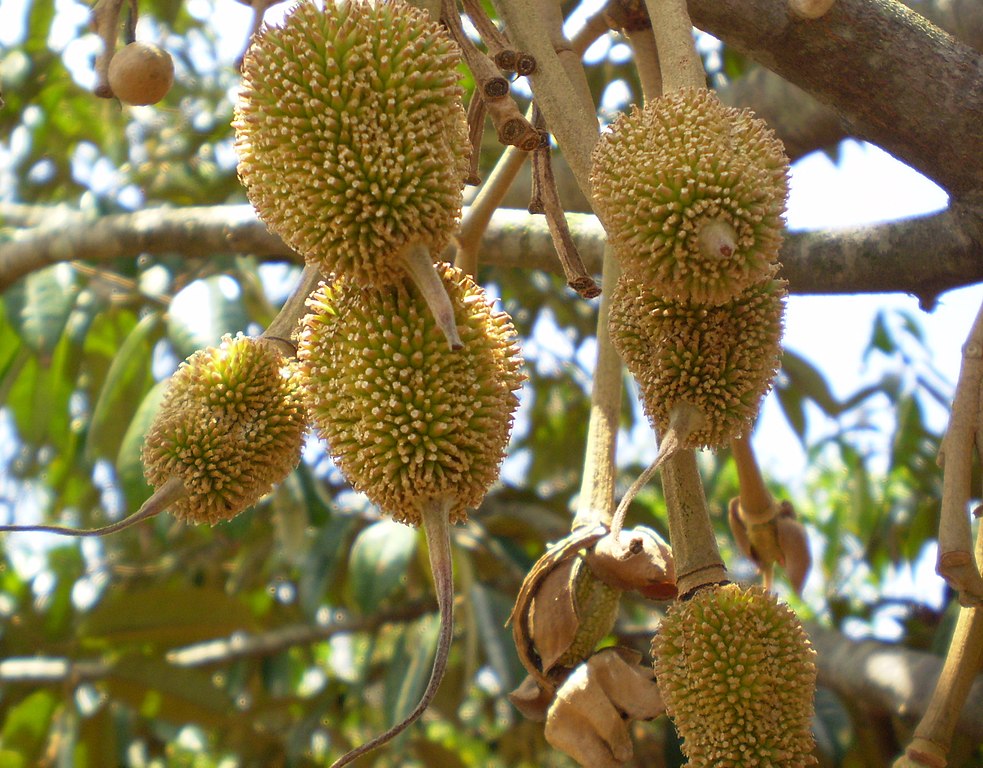 © Wikimedia.org/DXLINH, CC BY-SA
© Wikimedia.org/DXLINH, CC BY-SA
Sambucus is a genus of flowering plants in the family Adoxaceae. The various species are commonly called elder or elderberry. The genus was formerly placed in the honeysuckle family, Caprifoliaceae, but was reclassified as Adoxaceae due to genetic and morphological comparisons to plants in the genus Adoxa. The oppositely arranged leaves are pinnate with 5–9 leaflets (or, rarely, 3 or 11). Each leaf is 5–30 cm (2–12 in) long, and the leaflets have serrated margins. They bear large clusters of small white or cream-colored flowers in late spring; these are followed by clusters of small black, blue-black, or red berries (rarely yellow or white). (Source: Wikipedia.org, CC BY-SA)
Feijoa sellowiana is a species of flowering plant in the myrtle family, Myrtaceae. It is native to the highlands of southern Brazil, eastern Paraguay, Uruguay, northern Argentina, and Colombia. It is widely cultivated as an ornamental tree and for its fruit. Common names include feijoa (/feɪˈʒoʊ.ə/, /-ˈhoʊ.ə/, or /ˈfiːdʒoʊ.ə/), pineapple guava and guavasteen, although it is not a true guava. It is an evergreen shrub or small tree, 1–7 metres (3.3–23.0 ft) in height. The fruit, known as feijoa, matures in autumn and is green, ellipsoid, and about the size of a chicken egg. It has a sweet, aromatic flavour, which tastes like pineapple, apple, and mint. The flesh is juicy and is divided into a clear, gelatinous seed pulp and a firmer, slightly granular, opaque flesh nearer the skin. The fruit falls to the ground when ripe and at its fullest flavour, but it may be picked from the tree prior to falling to prevent bruising. (Source: Wikipedia.org, CC BY-SA)
The fig is the edible fruit of Ficus carica, a species of small tree in the flowering plant family Moraceae. Native to the Mediterranean and western Asia, it has been cultivated since ancient times and is now widely grown throughout the world, both for its fruit and as an ornamental plant. Ficus carica is the type species of the genus Ficus, containing over 800 tropical and subtropical plant species. A fig plant is a small deciduous tree or large shrub growing up to 7–10 m (23–33 ft) tall, with smooth white bark. Its large leaves have three to five deep lobes. Its fruit (referred to as syconium, a type of multiple fruit) is tear-shaped, 3–5 cm (1–2 in) long, with a green skin that may ripen toward purple or brown, and sweet soft reddish flesh containing numerous crunchy seeds. The milky sap of the green parts is an irritant to human skin. In the Northern Hemisphere, fresh figs are in season from late summer to early autumn. They tolerate moderate seasonal frost and can be grown even in hot-summer continental climates. (Source: Wikipedia.org, CC BY-SA)
Gooseberry (/ˈɡuːsbɛri/ or /ˈɡuːzbɛri/ (American and northern British) or /ˈɡʊzbəri/ (southern British)) is a common name for many species of Ribes (which also includes currants), as well as a large number of plants of similar appearance. The berries of those in the genus Ribes (sometimes placed in the genus Grossularia) are edible and may be green, orange, red, purple, yellow, white, or black. Humans cultivate gooseberries as insect habitats or directly for the sweet fruits. Numerous cultivars have been developed for both commercial and domestic use. Of special note are Ribes 'Careless', 'Greenfinch', 'Invicta', 'Leveller', and 'Whinham's Industry', to which the Royal Horticultural Society has awarded Garden Merit. Ribes gooseberries are commonly raised from cuttings rather than seed; cuttings planted in the autumn will take root quickly and begin to bear fruit within a few years. Nevertheless, bushes planted from seed also rapidly reach maturity, exhibit similar pest-tolerance, and yield heavily. Fruit is produced on lateral spurs and the previous year's shoots. (Source: Wikipedia.org, CC BY-SA)
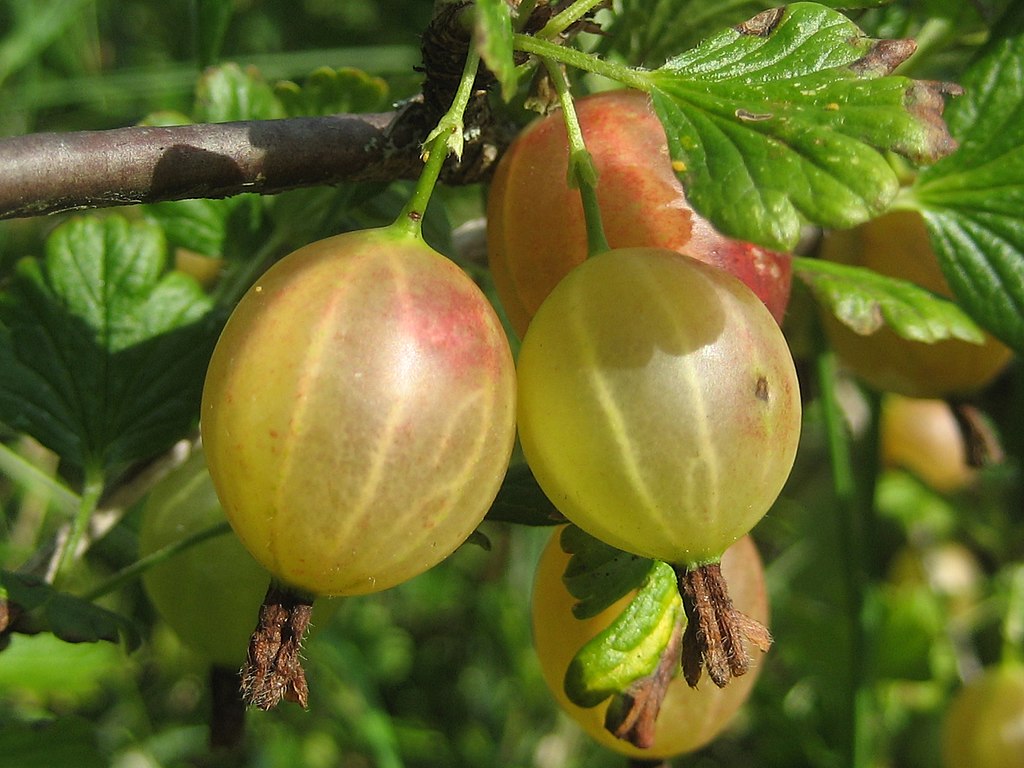 © Wikimedia.org/Pavel Leman, CC BY-SA
© Wikimedia.org/Pavel Leman, CC BY-SA
The grapefruit (Citrus × paradisi) is a subtropical citrus tree known for its relatively large, sour to semi-sweet, somewhat bitter fruit. The interior flesh is segmented and varies in color from pale yellow to dark pink. Grapefruit is a citrus hybrid originating in Barbados. It is an accidental cross between the sweet orange (C. sinensis) and the pomelo or shaddock (C. maxima), both of which were introduced from Asia in the 17th century. It has also been called the forbidden fruit. In the past it was referred to as the pomelo, but that term is now mostly used as the common name for Citrus maxima. In 2019, world production of grapefruits (combined with pomelos) was 9.3 million tonnes, of which 53% was in China. Other significant producers include Vietnam, United States and Mexico. (Source: Wikipedia.org, CC BY-SA)
A grape is a fruit, botanically a berry, of the deciduous woody vines of the flowering plant genus Vitis. Grapes are a non-climacteric type of fruit, generally occurring in clusters. The cultivation of grapes began perhaps 8,000 years ago, and the fruit has been used as human food over history. Eaten fresh or in dried form (as raisins, currants and sultanas), grapes also hold cultural significance in many parts of the world, particularly for their role in winemaking. Other grape-derived products include various types of jam, juice, vinegar and oil. Grapes are a type of fruit that grow in clusters of 15 to 300, and can be crimson, black, dark blue, yellow, green, orange, and pink. 'White' grapes are actually green in color, and are evolutionarily derived from the purple grape. Mutations in two regulatory genes of white grapes turn off production of anthocyanins, which are responsible for the color of purple grapes. Anthocyanins and other pigment chemicals of the larger family of polyphenols in purple grapes are responsible for the varying shades of purple in red wines. Grapes are typically an ellipsoid shape resembling a prolate spheroid. (Source: Wikipedia.org, CC BY-SA)
 © Wikimedia.org/Tomas Castelazo, CC BY
© Wikimedia.org/Tomas Castelazo, CC BY
Guava (/ˈɡwɑːvə/) is a common tropical fruit cultivated in many tropical and subtropical regions. The common guava Psidium guajava (lemon guava, apple guava) is a small tree in the myrtle family (Myrtaceae), native to Mexico, Central America, the Caribbean and northern South America. The name guava is also given to some other species in the genus Psidium such as strawberry guava (Psidium cattleyanum) and to the pineapple guava, Feijoa sellowiana. In 2019, 55 million tonnes of guavas were produced worldwide, led by India with 45% of the total. Botanically, guavas are berries. Guava fruits, usually 4 to 12 centimetres (1+1⁄2 to 4+1⁄2 in) long, are round or oval depending on the species. They have a pronounced and typical fragrance, similar to lemon rind but less sharp. The outer skin may be rough, often with a bitter taste, or soft and sweet. Varying between species, the skin can be any thickness, is usually green before maturity, but may be yellow, maroon, or green when ripe. The pulp inside may be sweet or sour and off-white ('white' guavas) to deep pink ('red' guavas). The seeds in the central pulp vary in number and hardness, depending on species. (Source: Wikipedia.org, CC BY-SA)
The honeydew melon is one of the two main cultivar types in Cucumis melo Inodorus Group. It is characterized by the smooth rind and lack of musky odor. The other main type in the Inodorus Group is the wrinkle-rind casaba melon. A honeydew has a round to slightly oval shape, typically 15–22 cm (5.9–8.7 in) long. It generally ranges in weight from 1.8 to 3.6 kg (4.0 to 7.9 lb). The flesh is usually pale green in color, while the smooth peel ranges from greenish to yellow. Like most fruit, honeydew has seeds. The inner flesh is eaten, often for dessert, and honeydew is commonly found in supermarkets across the world alongside cantaloupe melons and watermelons. In California, honeydew is in season from August until October. This fruit grows best in semiarid climates and is harvested based on maturity, not size. Maturity can be hard to judge, but it is based upon the ground color ranging from greenish white (immature) to creamy yellow (mature). Quality is also determined by the honeydew having a nearly spherical shape with a surface free of scars or defects. A honeydew should also feel heavy for its size and have a waxy rather than a fuzzy surface. This reflects the integrity and quality of its flesh as the weight can be attributed to the high water content of the ripened fruit. A lack of fuzz distinguishes a ripened honeydew from an unripened one as it is a sign of growth still having been underway when harvested. (Source: Wikipedia.org, CC BY-SA)
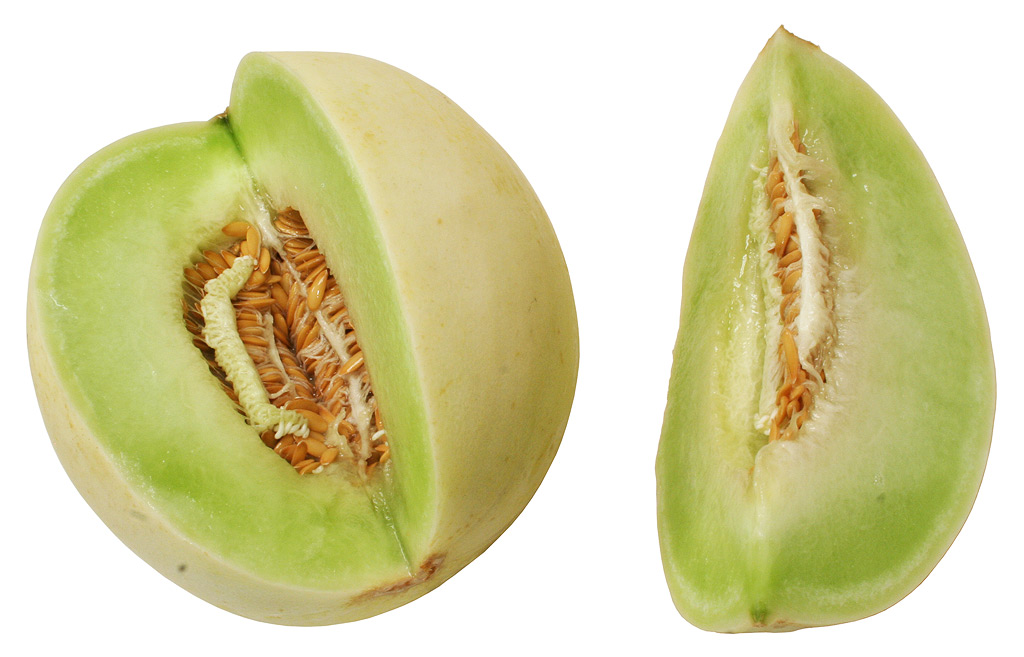 © Wikimedia.org/Yotoen, CC0
© Wikimedia.org/Yotoen, CC0
The jackfruit (Artocarpus heterophyllus), also known as jack tree, is a species of tree in the fig, mulberry, and breadfruit family (Moraceae). Its origin is in the region between the Western Ghats of southern India, all of Bangladesh, Sri Lanka, and the rainforests of the Philippines, Indonesia, and Malaysia. The jack tree is well-suited to tropical lowlands, and is widely cultivated throughout tropical regions of the world. It bears the largest fruit of all trees, reaching as much as 55 kg (120 pounds) in weight, 90 cm (35 inches) in length, and 50 cm (20 inches) in diameter. A mature jack tree produces some 200 fruits per year, with older trees bearing up to 500 fruits in a year. The jackfruit is a multiple fruit composed of hundreds to thousands of individual flowers, and the fleshy petals of the unripe fruit are eaten. The ripe fruit is sweet (depending on variety) and is more often used for desserts. Canned green jackfruit has a mild taste and meat-like texture that lends itself to being called a 'vegetable meat'. Jackfruit is commonly used in South and Southeast Asian cuisines. Both ripe and unripe fruits are consumed. It is available internationally canned or frozen and in chilled meals as are various products derived from the fruit such as noodles and chips. (Source: Wikipedia.org, CC BY-SA)
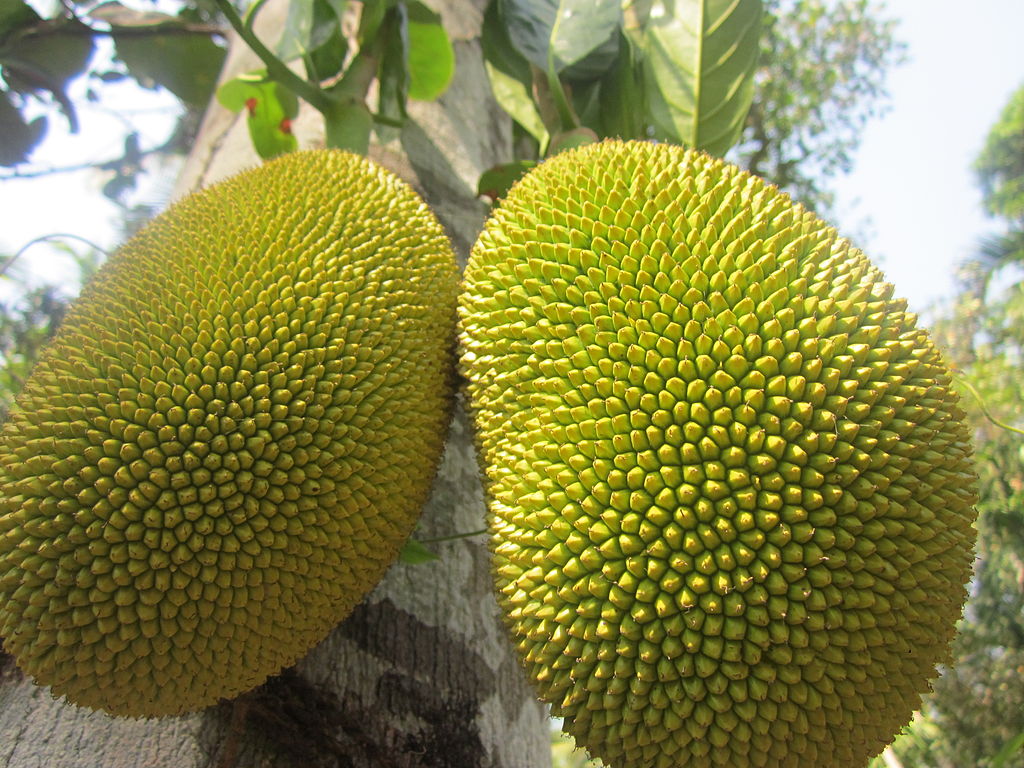 © Wikimedia.org/Chandana12, CC BY-SA
© Wikimedia.org/Chandana12, CC BY-SA
Syzygium cumini, commonly known as Malabar plum, Java plum, black plum, jamun, jaman, jambul, or jambolan, is an evergreen tropical tree in the flowering plant family Myrtaceae, and favored for its fruit, timber, and ornamental value. It is native to the Indian subcontinent, adjoining regions of Southeast Asia, including Myanmar, Sri Lanka, and the Andaman Islands. It can reach heights of up to 30 metres (98 ft) and can live more than 100 years. A rapidly growing plant, it is considered an invasive species in many world regions. The name of the fruit, black plum, is sometimes mistranslated as blackberry, which is a different fruit in an unrelated order. Syzygium cumini has been introduced to areas including islands of the Pacific and Indian Oceans, Australia, Hong Kong and Singapore. The tree was introduced to Florida in 1911 by the United States Department of Agriculture, and is commonly grown in tropical and subtropical regions worldwide. Its fruits are eaten by various native birds and small mammals, such as jackals, civets, and fruit bats. (Source: Wikipedia.org, CC BY-SA)
Jujube (/ˈdʒuːdʒuːb/), sometimes jujuba, known by the scientific name Ziziphus jujuba and also called red date, Chinese date, and Chinese jujube, is a species in the genus Ziziphus in the buckthorn family Rhamnaceae. It is a small deciduous tree or shrub reaching a height of 5–12 metres (16–39 feet), usually with thorny branches. The leaves are shiny-green, ovate-acute, 2–7 centimetres (3⁄4–2+3⁄4 inches) long and 1–3 cm (3⁄8–1+1⁄8 in) wide, with three conspicuous veins at the base, and a finely toothed margin. The flowers are small, 5 millimetres (1⁄4 in) wide, with five inconspicuous yellowish-green petals. The fruit is an edible oval drupe 1.5–3 cm (5⁄8–1+1⁄8 in) deep; when immature it is smooth-green, with the consistency and taste of an apple with lower acidity, maturing brown to purplish-black, and eventually wrinkled, looking like a small date. There is a single hard kernel, similar to an olive pit, containing two seeds. (Source: Wikipedia.org, CC BY-SA)
Kiwifruit (often shortened to kiwi in North American, British and continental European English) or Chinese gooseberry is the edible berry of several species of woody vines in the genus Actinidia. The most common cultivar group of kiwifruit (Actinidia deliciosa 'Hayward') is oval, about the size of a large hen's egg: 5–8 centimetres (2–3 inches) in length and 4.5–5.5 cm (1+3⁄4–2+1⁄4 in) in diameter. It has a thin, fuzzy, fibrous, tart but edible light brown skin and light green or golden flesh with rows of tiny, black, edible seeds. The fruit has a soft texture with a sweet and unique flavour. Kiwifruit is native to central and eastern China. The first recorded description of the kiwifruit dates to the 12th century during the Song dynasty. In the early 20th century, cultivation of kiwifruit spread from China to New Zealand, where the first commercial plantings occurred. The fruit became popular with British and American servicemen stationed in New Zealand during World War II, and later became commonly exported, first to Great Britain and then to California in the 1960s. (Source: Wikipedia.org, CC BY-SA)
Kumquats (/ˈkʌmkwɒt/; Chinese: 金桔), or cumquats in Australian English, are a group of small fruit-bearing trees in the flowering plant family Rutaceae. Their taxonomy is disputed. They were previously classified as forming the now-historical genus Fortunella or placed within Citrus, sensu lato. Different classifications have alternatively assigned them to anywhere from a single species, C. japonica, to numerous species representing each cultivar. Recent genomic analysis would define three pure species, Citrus hindsii, C. margarita and C. crassifolia, with C. x japonica being a hybrid of the last two. The edible fruit closely resembles the orange (Citrus sinensis) in color and shape but is much smaller, being approximately the size of a large olive. The kumquat is a fairly cold-hardy citrus. (Source: Wikipedia.org, CC BY-SA)
The lemon (Citrus limon) is a species of small evergreen trees in the flowering plant family Rutaceae, native to Asia, primarily Northeast India (Assam), Northern Myanmar or China. The tree's ellipsoidal yellow fruit is used for culinary and non-culinary purposes throughout the world, primarily for its juice, which has both culinary and cleaning uses. The pulp and rind are also used in cooking and baking. The juice of the lemon is about 5% to 6% citric acid, with a pH of around 2.2, giving it a sour taste. The distinctive sour taste of lemon juice makes it a key ingredient in drinks and foods such as lemonade and lemon meringue pie. Lemon is a rich source of vitamin C, providing 64% of the Daily Value in a 100 g reference amount (table). Other essential nutrients are low in content. Lemons contain numerous phytochemicals, including polyphenols, terpenes, and tannins. Lemon juice contains slightly more citric acid than lime juice (about 47 g/L), nearly twice the citric acid of grapefruit juice, and about five times the amount of citric acid found in orange juice. (Source: Wikipedia.org, CC BY-SA)
A lime (from French lime, from Arabic līma, from Persian līmū, 'lemon') is a citrus fruit, which is typically round, green in color, 3–6 centimetres (1.2–2.4 in) in diameter, and contains acidic juice vesicles. There are several species of citrus trees whose fruits are called limes, including the Key lime (Citrus aurantiifolia), Persian lime, Makrut lime, and desert lime. Limes are a rich source of vitamin C, are sour, and are often used to accent the flavours of foods and beverages. They are grown year-round. Plants with fruit called 'limes' have diverse genetic origins; limes do not form a monophyletic group. Raw limes are 88% water, 10% carbohydrates and less than 1% each of fat and protein (table). Only vitamin C content at 35% of the Daily Value (DV) per 100 g serving is significant for nutrition, with other nutrients present in low DV amounts (table). Lime juice contains slightly less citric acid than lemon juice (about 47 g/L), nearly twice the citric acid of grapefruit juice, and about five times the amount of citric acid found in orange juice. Lime pulp and peel contain diverse phytochemicals, including polyphenols and terpenes, many of which are under basic research for their potential properties in humans. (Source: Wikipedia.org, CC BY-SA)
Dimocarpus longan, commonly known as the longan (/ˈlɒŋɡən/) and dragon's eye, is a tropical tree species that produces edible fruit. It is one of the better-known tropical members of the soapberry family Sapindaceae, to which the lychee and rambutan also belong. The fruit of the longan is similar to that of the lychee, but less aromatic in taste. It is native to tropical Asia and China. The longan (from Cantonese lùhng-ngáahn 龍眼, literally 'dragon eye'), is so named because it resembles an eyeball when its fruit is shelled (the black seed shows through the translucent flesh like a pupil and iris). The seed is small, round and hard, and of an enamel-like, lacquered black. The fully ripened, freshly harvested fruit has a bark-like shell, thin, and firm, making the fruit easy to peel by squeezing the pulp out as if one were 'cracking' a sunflower seed. When the shell has more moisture content and is more tender, the fruit becomes less convenient to shell. The tenderness of the shell varies due to either premature harvest, variety, weather conditions or storage conditions. (Source: Wikipedia.org, CC BY-SA)
The loquat (Eriobotrya japonica) is a large evergreen shrub or tree, grown commercially for its orange fruit and for its leaves, which are used to make herbal tea. It is also cultivated as an ornamental plant. The loquat is in the family Rosaceae, and is native to the cooler hill regions of south-central China. In Japan the loquat is known as biwa (枇杷, びわ) and has been grown for over 1,000 years. The loquat has been introduced to regions with subtropical to mild temperate climates throughout the world. Eriobotrya japonica was formerly thought to be closely related to the genus Mespilus, and is still sometimes mistakenly known as the Japanese medlar. It is also known as Japanese plum and Chinese plum, as well as pipa in China, naspli in Malta, Lukaat in India, Lucat in Sri Lanka, níspero in Spain, nêspera in Portugal, shések in Israel, akidéné in Lebanon, Ebirangweti in Kisii and nespolo in Italy (where the name is shared with Mespilus germanica). (Source: Wikipedia.org, CC BY-SA)
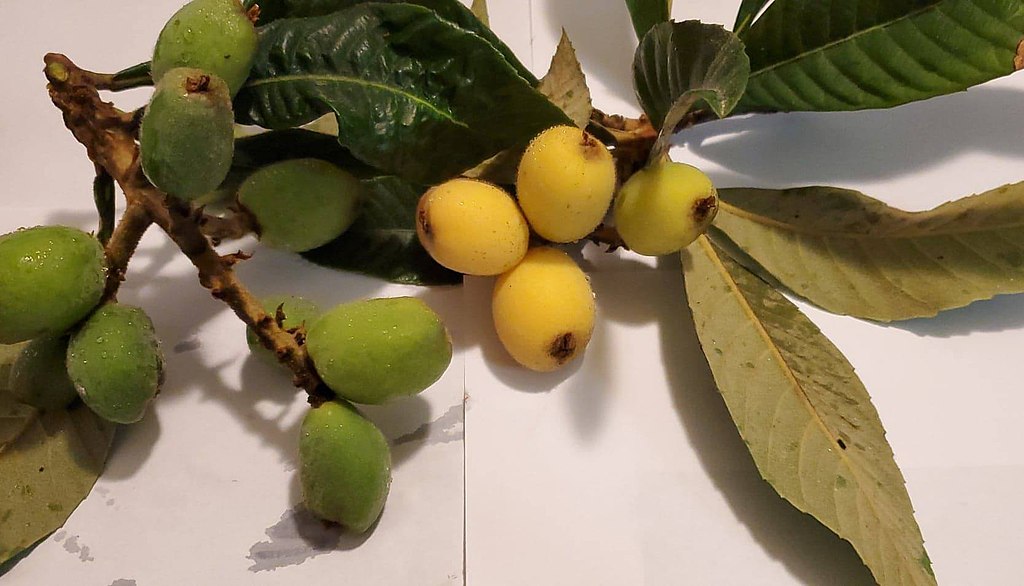 © Wikimedia.org/Mosenge1, CC BY-SA
© Wikimedia.org/Mosenge1, CC BY-SA
Lychee (US: /ˈliːˌtʃiː/ LEE-chee; UK: /ˈlaɪˌtʃiː/ LIE-chee; Litchi chinensis; Chinese: 荔枝; pinyin: lìzhī; Jyutping: lai6 zi1; Pe̍h-ōe-jī: nāi-chi) is a monotypic taxon and the sole member in the genus Litchi in the soapberry family, Sapindaceae. It is a tropical tree native to the Guangdong, Fujian, and Yunnan provinces of Southeast and Southwest China, where cultivation is documented from the 11th century. China is the main producer of lychees, followed by Vietnam, India, other countries in Southeast Asia, the Indian Subcontinent, Madagascar and South Africa. A tall evergreen tree, the lychee bears small fleshy fruits. The outside of the fruit is pink-red, roughly textured, and inedible, covering sweet flesh eaten in many different dessert dishes. Lychee seeds contain methylene cyclopropyl glycine which can cause hypoglycemia associated with outbreaks of encephalopathy in undernourished Indian and Vietnamese children who had consumed lychee fruit. (Source: Wikipedia.org, CC BY-SA)
The mandarin orange (Citrus reticulata), also known as the mandarin or mandarine, is a small citrus tree fruit. Treated as a distinct species of orange, it is usually eaten plain or in fruit salads. Tangerines are a group of orange-coloured citrus fruit consisting of hybrids of mandarin orange with some pomelo contribution. Mandarins are smaller and oblate, unlike the spherical common oranges (which are a mandarin–pomelo hybrid). The taste is considered sweeter and stronger than the common orange. A ripe mandarin is firm to slightly soft, heavy for its size, and pebbly-skinned. The peel is thin, loose, with little white mesocarp, so they are usually easier to peel and to split into segments. Hybrids usually have these traits to a lesser degree. The mandarin is tender and is damaged easily by cold. It can be grown in tropical and subtropical areas. According to genetic studies, the mandarin was one of the original citrus species; through breeding or natural hybridization, it is the ancestor of many hybrid citrus cultivars. With the citron and pomelo, it is the ancestor of the most commercially important hybrids (such as sweet and sour oranges, grapefruit, and many lemons and limes). The mandarin has also been hybridized with other citrus species, such as the desert lime and the kumquat. Though the ancestral mandarin was bitter, most commercial mandarin strains derive from hybridization with pomelo, which give them a sweet fruit. (Source: Wikipedia.org, CC BY-SA)
A mango is an edible stone fruit produced by the tropical tree Mangifera indica. It is believed to have originated in the region between northwestern Myanmar, Bangladesh, and northeastern India. M. indica has been cultivated in South and Southeast Asia since ancient times resulting in two types of modern mango cultivars: the 'Indian type' and the 'Southeast Asian type'. Other species in the genus Mangifera also produce edible fruits that are also called 'mangoes', the majority of which are found in the Malesian ecoregion. Worldwide, there are several hundred cultivars of mango. Depending on the cultivar, mango fruit varies in size, shape, sweetness, skin color, and flesh color which may be pale yellow, gold, green, or orange. Mango is the national fruit of India, Pakistan and the Philippines, while the mango tree is the national tree of Bangladesh. (Source: Wikipedia.org, CC BY-SA)
Mangosteen (Garcinia mangostana), also known as the purple mangosteen, is a tropical evergreen tree with edible fruit native to tropical lands surrounding the Indian Ocean. Its origin is uncertain due to widespread prehistoric cultivation. It grows mainly in Southeast Asia, southwest India and other tropical areas such as Colombia and Puerto Rico, where the tree has been introduced. The tree grows from 6 to 25 metres (20 to 82 feet) tall. The fruit of the mangosteen is sweet and tangy, juicy, somewhat fibrous, with fluid-filled vesicles (like the flesh of citrus fruits), with an inedible, deep reddish-purple colored rind (exocarp) when ripe. In each fruit, the fragrant edible flesh that surrounds each seed is botanically endocarp, i.e., the inner layer of the ovary. The seeds are of similar size and shape to almonds. (Source: Wikipedia.org, CC BY-SA)
Morus, a genus of flowering plants in the family Moraceae, consists of diverse species of deciduous trees commonly known as mulberries, growing wild and under cultivation in many temperate world regions. Generally, the genus has 64 identified species, three of which are well-known and are ostensibly named for the fruit color of the best-known cultivar: white, red, and black mulberry (Morus alba, M. rubra, and M. nigra, respectively), with numerous cultivars. M. alba is native to South Asia, but is widely distributed across Europe, Southern Africa, South America, and North America. M. alba is also the species most preferred by the silkworm, and is regarded as an invasive species in Brazil and the United States. Mulberries are fast-growing when young, and can grow to 24 metres (79 feet) tall. The leaves are alternately arranged, simple, and often lobed and serrated on the margin. Lobes are more common on juvenile shoots than on mature trees. The trees can be monoecious or dioecious. (Source: Wikipedia.org, CC BY-SA)

Time for recess! Post a comment, ask a question or write a review. Feel free to let us know what you think!
Some terms were different than my study book, and I found that confusing. Also the car alert signs were something I had not studied at all, good to learn something new.
Below are wonderful knowledge resources for foreigners willing to Drive in Malaysia: Driving in Malaysia: What Foreign National Drivers Should Know? https://driveinmalaysia.com/blog/2022/driving-in-malaysia-what-foreign-national-drivers-should-know/ What Foreign Students in Malaysia Should Know about Driving Licence and its Conversion? https://driveinmalaysia.com/blog/2024/guide-on-malaysian-driving-license-and-its-conversion-for-foreign-students/
when you have a wrong answer the next will be counted wrong too no matter if it's right. This could leed to confusion.
Amazing website with all basic Rules .Much more appreciated and my sincere gratitude .
81/85 as an Italian who never drove in US, wonder if that's enough to pass the licence test there?
look at the sign on the road to avoid accidents and horrible driving conditions
I received a 300$ ticket because I passed a police control of other cars/drivers on the right lane of a highway (the control was on the hard shoulder of the highway). Is it really true, that you have to change the lane in such cases? Thanks!
More community